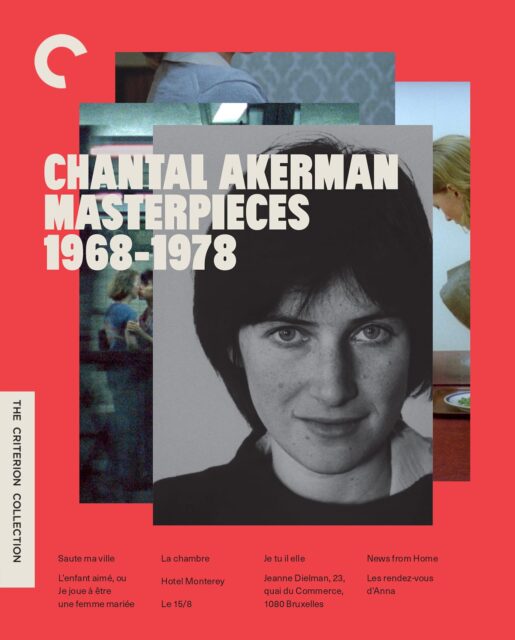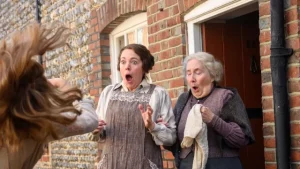
The post Home Video Hovel: Chantal Akerman Masterpieces 1968-1978, by Scott Nye appeared first on Battleship Pretension.
“I’m not militant, I simply make films that are not colonized, that have not been filtered through the language of men, and that’s a matter of confidence… I’m 27 now, and I have everything to gain… I think I’m making films that are very close to how I feel and to what I am, and I don’t speak the language of men to express myself.” – Chantal Akerman, 1977
After Chantal Akerman’s Jeanne Dielman, 23 quai du Commerce, 1080 Bruxelles topped the 2022 Sight & Sound critics poll, causing equal measures outrage and celebration, there’s been renewed, long overdue interest in the late Belgian filmmaker’s work. Unlike Orson Welles, who with Citizen Kane similarly made a film in his mid-twenties that would cling to him the rest of his life, Akerman didn’t live to see her masterpiece gets its proper due – she died by suicide on October 5th, 2015, two months after her last film, No Home Movie, premiered to the familiar divisive reactions that defined her career. She never really got her due in her lifetime, and like Welles, spent most of her career trying to solicit funding for new work that her early acclaim seemed unable to guarantee.
The Criterion Collection, thankfully, has done an excellent job of making her work available where possible – first by releasing Jeanne Dielman on DVD in 2007, then a collection five of her 1970s films in 2010, followed by a Blu-ray reissue of Jeanne on Blu-ray in 2017. Their latest release, Chantal Akerman Masterpieces 1968-1978, combines those releases, upgrading all to Blu, and adding new films to it, resulting in the best edition of her work in the English-speaking world to date. In presenting, comprehensively, the first decade of her career, it serves as not only a vital introduction for new viewers, but a way for those who have loved her for years to find renewed appreciation of it as well.
The set includes all the features – Hotel Monterey (1972), Je tu il elle (1975), Jeanne Dielman (1975), News From Home (1976), and Les rendezvous d’Anna (1978) – and short films – Saute ma ville (1968), L’enfant aimé ou Je joue à être une femme mariée (1971), La chambre (1972), Le 15/8 (1973) – she made in that period. Taken as a whole, it represents one of the most fertile first decades for any filmmaker, a time of wild experimentation, diverse tones and genres, massive acclaim, and near-penniless determination. Her continuing subject in this period and throughout her career – the sense of feeling trapped, and the hell of being free – finds continuous purchase in depictions of depression, isolation, loneliness, and, from time to time, sexual excitement.
“I hide in one room or the other, then am ashamed of my hiding.” – Chantal Akerman, My Mother Laughs (2013)
The earliest films represent at once an intense period of searching and remarkable clarity of vision. Saute ma ville, a rare out-and-out comedy, shows a young woman (played by Akerman) alone in her kitchen cleaning, cooking, and eventually descending into anarchy before blowing up her apartment (and, the title suggests, the town altogether). L’enfant aimé (one of two new-to-Criterion shorts) is more introspective, but with an air of distance, literalizing a perspective she would take for the bulk of her fiction work. Here, Akerman plays a friend and confidant to the film’s main subject (played by Claire Wauthion), a weary housewife and young mother who tells Akerman of her melancholy about her marriage, her body, and her life altogether spent waiting on or for a man she increasingly does not know.
That sense of one’s thoughts constantly rattling against one another crops up again in Le 15/8 (the second film that will be new to most viewing this set), which depicts a young woman (Chris Myllykoski) staying in an acquaintance’s Parisian apartment, perhaps getting a fresh start in the city, but terrified to go outside, constantly reminding herself of the dangers – from men, animals, the city itself – that might await her.
In between those two European-set films, Akerman spent a little over a year in New York, where she met cinematographer Babette Mangolte, with whom she made the short La chambre and her first feature, Hotel Monterey (as well as initiating production on the unfinished Hanging Out in Yonkers, footage of which is available on this set). Hotel Monterey is often classified as a documentary, a category it sits in somewhat uneasily. Shot over the course of a single night, it’s more like an avant-garde exploration of the nature of rented space, the quiet halls (the film has no soundtrack), odd bursts of artificial light, and corporeal forms you temporarily call your neighbors. It gives The Shining a run for its money in making a hotel feel like another plane of existence. This energy more actively informs La chambre, in which a camera rotates – then reverses! – around an apartment, occasionally catching a glimpse of an enigmatic woman (Akerman) lounging in bed, playing with an apple, and staring at the camera.
After returning to Europe and making Le 15/8, Akerman had a greater sense of herself and what she wanted to accomplish with film, which is on full display in Je tu il elle. Akerman stars as Julie, a restless woman trapped in her own apartment, but constantly making overtures to the outside world – she composes and recomposes a letter, eats a lot of raw sugar, watches people pass by her large window, and puts herself on naked display for anyone who happens to walk by. For much of this section, with its often-static camera and minimal sound, you could wonder if she made this entirely by herself. Then, she’s thrust out on the road, talking to and engaging in casual sex with a truck driver (Niels Arestrup), who like the young mother in L’enfant aimé, finds in the largely-silent Akerman character a trusted companion to hear his many woes. In the third section, we uncover the source of much of her own present listlessness, in an ex-girlfriend (Wauthion again) whom Julie manages to seduce for at least one more night. Their sex scene, as much a wrestling match at lovemaking, expressing the combative lust former lovers feel for one another, lasts twelve minutes and is depicted in only a few static shots.
Delphine Seyrig, a renowned French actress and herself an ardent feminist (she made several revolutionarily-spirited short- and medium-length films in this period), saw in Akerman an ideal collaborator, a major young voice for women’s issues. Akerman furthered their political initiative by crewing the film with mainly women (including Mangolte as cinematographer), and set about making what would become her defining work. Jeanne Dielman, 23 quai du Commerce, 1080 Bruxelles is a three-and-a-half-hour epic covering three days in the life of a widowed mother of a teenage boy. Her days are carefully-scheduled and her modest apartment neatly arranged to accommodate her exacting nature. Her biggest risk comes with her profession – she makes money having sex with a different client each day, each of whom arrives at a precise time, usually while she has potatoes boiling or meatloaf baking. The camera observes her in static shots, some of which she wanders into and out of. Unexpectedly, and – if you’ve given yourself over to the film, particularly in a theatrical setting – quite shockingly, her routine becomes unmoored in very small ways that gradually add up, and begin to create a tension we in the audience can neither identify nor help her resolve. We, like her, are trapped in the chamber of thoughts Akerman had dramatized in her prior work, but now leaves entirely to our fertile imagination.
Jeanne Dielman was equally celebrated and derided even on release, a reputation that has stayed with it ever since. As regrettable as many of the negative reactions to the Sight & Sound list have been – tinged as they are with misogyny and a rigid sense of stubborn canonical thinking – it is in some ways refreshing that a film approaching its fiftieth anniversary can still cause as much outrage and confusion today as it did upon its premiere. There is sometimes a notion that old films are calcified and cemented, but it does the heart good to see Akerman still upsetting people just the right way. It is a bold, striking, and shocking work, and should anger at least a few.
One senses in her next two films the world really opening up to Akerman – she goes to New York to make No Home Movie, my favorite of her films, an overwhelmingly emotional remembrance of her time in the city, a series of static shots of her old haunts with ambient sounds and a narration track in which Akerman reads the letters her mother sent her during this period. The letters cover banal details of family life, her work, overtures for more letters from Akerman (which we never hear), and inquiries about her life and financial status. The lack of any personal specifics of Akerman’s own time there, these shots of the city bereft of close friends or routine pleasures, paints a lonely portrait of this period in her life, a feeling of being away from family for the first time, alone in a new country whose language she only somewhat speaks, and the uncertainty of where her life is heading. In interviews, Akerman recalls this as an exciting, happy time, but the film gives her a way to express the interiority of being twenty-one and too far away from your roots.
Les rendez-vous d’Anna is a more elaborate affair, a journey through West Germany, Belgium, and France, with an Akerman surrogate (Aurore Clément) touring to promote her new film, much as Akerman would have been with Jeanne Dielman. Yet once again, her protagonist is largely a passive figure, in whom others entrust their secrets, doubts, and fears, in poetic monologues through transient spaces – hotels, trains, et cetera. The truest dialogue Anne has is with her mother (Lea Massari), who meets her for an evening, much of her dialogue clearly taken from Akerman’s own mother’s letters we heard in News From Home. While not as overtly bold as her prior two films, Les rendez-vous is a major step forward for Akerman in developing her capacity for choreographing the elements of cinema, most especially a larger cast, and finding new ways of expressing her central themes in choreographing them in their environments. I suppose that makes it all sound a bit academic, but the truth is it’s a beautiful, very moving film.
A series of portraits of people who have only their home or no home at all, cut too far into themselves to understand how to be part of the world. In some ways, it’s no wonder it took the pandemic, when we finally saw the terrifying nature of home life, to put Akerman so firmly into the fore of contemporary taste.
Criterion’s new box set is thoroughly lovely, sporting recent restorations of the films from the Royal Film Archive of Belgium. I’ll get the easy one out of the way – in a one-to-one comparison, I didn’t notice any discernible difference in the Jeanne Dielman transfer here as compared to Criterion’s 2017 Blu-ray, which was really one of the modern miracles of contemporary disc authoring. It looks like the bitrate for the film is a bit higher on this one, though, due to Criterion smartly splitting the supplements across the discs a bit (more on that shortly). Grain is fine and steady, and while there’s a slight flutter to the image (which I appreciate on 35mm transfers), it’s quite stable, more so than you get theatrically anyway. Jeanne Dielman can be found on disc two of this set. Saute ma ville also looks as it did as a supplement on the Jeanne Dielman disc, though it’s been put on a separate disc with the earlier films – easily the most “modern” looking of the black-and-white transfers here, it’s very clean and well-preserved, few scratches, great contrast and stability.
Then things get interesting. I’m quite fond of films looking like films on their digital transfers, so these were all extremely pleasing to me. L’enfant aimé is super grainy, sometimes blown-out, and a little soft, with persistent specks, scratches, and damage marks. It’s a half-hour rare short film that has probably not had the best preservation history, and a lot of this could be baked into the production to boot. Le 15/8 is cleaner and clearer, with healthy, pleasing grain and flicker, but still has some hallmarks inherent to its low-budget production (hairs in the frame, specks of dirt, etc.). There’s a lot of unexpected, tricky depth in it (in one shot 17 minutes in, Myllykoski sits smoking a cigarette next to an open window, the glass of which reflects her arm and a table set in front of her, all of which we can see way back into thanks to the clarity of the transfer. Stability varies shot to shot.
Moving onto the upgrades from the Eclipse set, each one is a marked upgrade, though not without some alterations. La chambre is the most radical of these – the DVD transfer was much more saturated, but naturally, detail wasn’t nearly as fine, and you didn’t get as robust an image all around. So this feels a bit more muted in its color palette, but one can more clearly see Akerman’s face, which goes a long way, and the light pouring in from the apartment window is much more finely textured. Hotel Monterey has the same sort of difference, with a softer color scheme and lower contrast, finding murky, grainy grays the DVD relegated to deep blacks. Compression is also a bit of an issue with this one – there’s just a lot of grain to render against very white lights that gets tricky to manage. Both are much better than the DVDs on a technical level, but depending on one’s aesthetic preferences, it might be worth holding onto that earlier edition if you have it.
Fortunately, the three features from that set are absolutely superior on Blu-ray. Je tu il elle may get some notices for those who dislike a little flavor in their transfers, but it has a much more dynamic appearance, with tons of detail the DVD pitched into pure darkness. Depth and detail are outstanding, and the transfer retains some of the “roughness” of the production in its flicker, grain, and damage, which vary greatly depending on the shooting environment, but feel very much like a healthy 35mm print. It felt like a massive breath of fresh air to a film I was sure I knew well.
Perhaps most importantly, for the three aforementioned films, their aspect ratio has been corrected from the DVD release, which squished them slightly into a frame closer to 1.30:1. The new Blu-rays bring them to the proper 1.37:1 aspect ratio.
All those films can be found on disc one.
Disc three presents News From Home and Les rendez-vous d’Anna in exceptionally fine transfers. Both films have very stable, robust color schemes, fine grain, minimal damage, and beautiful lighting. Once again, despite my familiarity with these films, and expecting only to put them on to check the transfers, I was quite immediately drawn to watch them all the way through due to just how appealing the new transfers are. Of all the films on the set, the colors are the most captivating here. News From Home is also presented with an English-language soundtrack, should you so desire.
“When my style started coming into fashion, it was no longer worth commenting on my style…” – Chantal Akerman, My Mother Laughs (2013); [she was speaking directly about clothing, but it’s more suggestive than that]
Onto the supplements. Everything from the solo Jeanne Dielman disc made it over, most notably “Autour de ‘Jeanne Dielman,’” the truly great hourlong documentary by Sami Frey (one of the stars of Godard’s Band of Outsiders) covering the production of that film. Sometimes uncomfortable, but always illuminating, it shows the conflicts that arise when Akerman, who has no experience on a professional shoot, has to account for the expectations of a major star like Seyrig. The actress is in some ways teaching Akerman how to direct, patiently if passive-aggressively, but one senses in these interactions a desire from both to improve the film, to make it more complex than they could envision alone. Akerman is just still maturing to a place of recognizing that, and Seyrig is not at all held back from asserting herself.
There are also two worthwhile interviews with Akerman, one on Dielman specifically, the other speaking more generally about her work, as well as with Mangolte and Seyrig and, most pleasurably, Akerman’s mother. Those who have seen No Home Movie (which I cannot recommend highly enough) will appreciate the last most, and those who haven’t will undoubtedly be eager to see more from them, as they have a fun, playful relationship.
New supplements start with some excellent early material from Akerman. Footage of Hanging Out Yonkers, her unfinished 1973 documentary, is available in high definition and looking great. It was abandoned when the sound rushes were lost, and consequently the footage is presented silently, best accepted as a glimpse into Akerman’s approach and the fashions amongst the youth of the day. Also on the rough footage side are some brief tests Akerman shot as part of her application to film school, from which she dropped out shortly after enrolling. The footage looks like it was scanned into high definition or 2K as-is, replete with damage and no stabilization, but at three minutes apiece, they’re a lot of fun to duck into, though I wish Criterion had put in a “Play All” option.
On the briefer side are an appreciation of Je tu il elle by filmmaker Ira Sachs, as well as an interview with Anna star Aurore Clément conducted by Akerman in 2007, which has some great recollections between the two of them.
We also get a really wonderful interview with film critic B. Ruby Rich who discusses what Akerman’s films mean to her and helps place them in their historical context. It’s a lovely introductory interview on the first disc that pairs brilliantly with a video essay by Valeria Rotella on the last disc, which takes excerpts of interviews with Akerman from this period about the films in this set and lays them over clips of her films. This was my favorite supplement on the set; to hear Akerman so full of hope and optimism at this early stage is a relatively rare treat, to hear her speak about this films fresh, without the benefit of decades of hindsight, just how they struck her in the moment.
Finally, we get a forty-page booklet with an essay and notes on each film by film critic Beatrice Loayza, who concisely encapsulates a lot about the whole package, and is well worth reading as you move through it. The booklet’s design is sometimes awkward, leaving unexpected bouts of empty space, but that’s a small detail.
The post Home Video Hovel: Chantal Akerman Masterpieces 1968-1978, by Scott Nye first appeared on Battleship Pretension.
The post Home Video Hovel: Chantal Akerman Masterpieces 1968-1978, by Scott Nye appeared first on Battleship Pretension.







